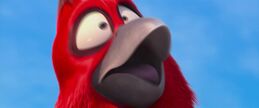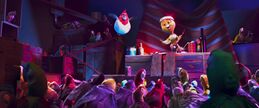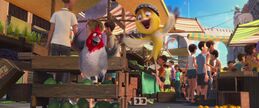This is the plot of the recently released 3D animation "Rio Adventure". And if you watch this movie purely as a comedy, it would be a bit of a waste. The animal species and animal behaviors in the film are actually "sentences" - there is a lot of scientific facts behind this story, just like watching An encyclopedia of birds.
"Rio Adventure" focuses the camera on parrots, allowing us to see many cute and unlovable behaviors of parrots: they can speak human words, learn to bark, climb high and low, skateboard... these are all is that true?
Uncover the true colors of those protagonists and supporting birds
Protagonist: A Blind Date Is True The
movie's protagonist, the little blue macaw, is real and one of the most endangered species of parrot in the world.
American ornithologist Dr. Joanna Berg once told a story in "My Parrot Boss" published in 2002, "Scientists once discovered what was thought to be the only wild little blue macaw in the world, In order to continue the bloodline of this species, they found a female companion of a different species for the male bird, hoping that they would give birth to the crystallization of love. The result was unsuccessful, and then they finally found another artificially raised female. The blue macaw was taken to the male's habitat in Brazil's northeastern province of Brasía to be released into the wild. Scientists expected the female to capture the male's heart and give birth to offspring, but the female eventually disappeared. "The
ending was happy in Rio, where Blue and Pearl ended up falling in love and having offspring in the protectorate. But this is not the case. At present, the little blue macaw may be extinct in the wild, and only one habitat has not been thoroughly investigated. There are currently about 100 little blue macaws in captivity, of which about 80 are in the Brazilian government's breeding and restoration program. They are the last hope of this species.
Contra angle: It's actually quite friendly
Since it is called "big adventure", there will definitely be villains. There is a villain in the film that makes people hate it - Nigel, the great white parrot.
The prototype of this bird is called "Sunflower Cockatoo", which belongs to a species of cockatoo. Nigel in the film is cruel, evil, and insidious. In fact, the sunflower cockatoo, which is native to Australia and New Guinea, is very friendly and is brought to all parts of the world as pets. It is the most famous cockatoo. When Nigel is angry, he will unfold the "sunflower"-shaped crest, which is the biggest characteristic of the sunflower cockatoo. Sunflower cockatoos are very adaptable. In countries such as Singapore, some sunflower cockatoos have adapted to the natural environment and survived.
Supporting Actors: Rare Birds Take Turns
In addition to parrots, there are many birds in the film that stand out. The most outstanding is the protagonist's good friend - the "good man" Raphael of the Gu family. Raphael's prototype is a whipping toucan.
Toucans are close relatives of woodpeckers, all found in Central and South America. Although the toucan has the word "giant" and looks quite "majestic" when looking at the pictures, it is actually not too big. The "lashing toucan" is the largest species of toucans. Their bodies are 60 cm to 70 cm long, which sounds close to 1 meter, but the length of the mouth occupies half of the body, and the body is only more than 30 cm. Similar to thrush. The seemingly huge beak of the whipping toucan is actually very light, only about 20 grams, as light as a sponge but also very hard.
In addition to whipping the toucan Raphael, the big supporting roles in the film, as well as the enthusiastic fat red bird Pedro and the little yellow bird Nico with the lid of the beer bottle.
The fat red bird is the crested bunting, a native of South America. Its English name literally translates to the red-crowned main cardinal, and the name comes from a koan in biology. The head of the crested wax-billed bunting does resemble the main cardinal. It was first classified under the jaguar family where the main cardinal belongs, and later moved to the bunting family.
The little yellow bird Nico with the lid of the beer bottle is the familiar canary, native to Africa, and later brought to the world by Europeans as a caged bird.
There is also a supporting role that is very important. In the bird and beast battle of the "Bird Club", a big bird played a key role. Its long legs "swept a large area" against the monkey. Later, the big bird also Send Blue and Pearl on the tram like a crane. The prototype of this bird is called "Pink Spoonbill". The mouth of the spoonbill is flat, like the shape of a lute, suitable for filtering small animals in the water. Pink spoonbills like to live in groups and were found throughout the Gulf of Mexico more than a hundred years ago, but are now fairly rare due to mass hunting by humans.
"Rio Adventure" Plot
This 3D cartoon tells a humorous adventure legend...
Bru is a little blue macaw bred by humans, so it never learns to spread its wings. He lives a comfortable and peaceful life in a small Minnesota town with his owner and best friend, Linda. Just when everyone thought that Blue should be the last little blue macaw left in the world, they got an important piece of information. It turned out that there was another living in Rio de Janeiro, Brazil, so Linda and Blue decided to work together. Go to this far-flung land to find Pearl, a little blue macaw a female presumed to be Bruce's "other half".
However, not long after arriving in Rio de Janeiro, Blue and Pearl didn't even have time to develop a relationship, they were kidnapped by a clumsy animal smuggling gang, and the street-smart Pearl and a group of people living in the city were kidnapped. With the help of various birds, Bruce managed to escape by luck.
Now, with these new friends, Blu must muster up the courage to learn how to fly, then dodge the bird traffickers who are following them closely and find a way to get back to Linda... The
parrot has
survived 5,000 on Earth. For thousands of years,
ornithologists named the group to which parrots belonged the order Parrots. There are currently 367 species of parrots on earth according to the latest records.
At the beginning of "Rio Adventure", we see parrots of different colors, sizes and shapes dancing hot dances in the forests of South America, just like a "parrot kingdom". In fact, this is also the case. South America represented by Brazil is the most important distribution area for parrots in the world, followed by Australia and the Pacific Islands.
According to the website of the China Wildlife Conservation Society, there are 9 species of wild parrots in China, including short-tailed parrots and red-breasted parrots, as well as two exotic parrots, the red-collared green parrot and the little sunflower cockatoo, which are also in the wild in China. Survive and multiply.
Parrots can't fly, but they are good at climbing and learning how to bark. Is this true?
Flying: There are parrots that can't fly.
In "Rio Adventure", Bruce, who is petted by humans, can't fly. Is there such a thing?
As Bruce, who can't fly but loves to read books, said: "There are more than 30 kinds of birds in the world that can't fly, such as ostriches." The most familiar flightless birds are ostriches and penguins. Others can't fly. The bird is much weaker. On some small islands, because there are no mammals, some birds fly here by accident, and because there are no ground predators, their flight ability becomes more and more degraded, and eventually they become flightless birds. The most famous ones include New Zealand's national bird "kiwi" and the extinct giant fat bird "dodo".
But you know what? There is also a flightless parrot, the New Zealand kakapo. The kakapo weighs 4 kilograms and walks around the ground every day to find small bugs to eat. Their upright walking posture and meat-eating facial features resemble owls, hence the name "Kakapo". In fact, Blue in "Rio Adventure" should not say "such as an ostrich", but should say "such as a kakapo".
Even if a parrot that was originally flying has been kept in a cage by humans for a long time, it may indeed lose the ability to fly, especially parrots raised from young birds.
Climbing: This is a parrot's long item.
Although he can't fly, Bruce's legs are not ambiguous. In the film, Blue shows extremely high climbing skills both in the owner Linda's house and in the process of escaping with the blind female parrot Pearl.
This is not the wishful thinking of the director and screenwriter, in fact, the claws of parrots are even more flexible than their wings.
Common features of parrots include a powerful curved beak, strong legs and claws. When parrots squat on a branch, they have two toes in front of them and two toes behind. This is biologically called "anti-toed feet", and these characteristics make them very good at climbing. Not only do parrots use two claws to climb, but their mouths often help, first bite with their mouths as a focal point, and then use their claws. The previously mentioned flightless kakapo relies mainly on climbing, and its wings are only used for decoration by gliding to the ground from trees and performing courtship dances.
In addition to climbing, the parrot's claws are also particularly good at grasping, and the scene in the film where Nigel grabs a bone and beats the cage is impressive. In reality, some parrots do grasp feathers to tickle themselves, and some domestic parrots learn to use spoons; Nigel's behavior is a "family inheritance" of cockatoos. The world's largest cockatoo, the palm cockatoo, will grab the branches and beat the trunk to transmit information; other cockatoos will grab some stones or branches and throw them out to drive away predators.
A study of Australian parrot species showed that parrots are "left-handed" and "right-handed" when they use their claws to grasp food: adult parrots always prefer to use one claw to grasp food.
Talking: Not Just
Learning Tongues In the film, Blue will learn to wake up the owner in the morning by the sound of the alarm clock; when running away, he will also learn the sound of the dog to scare away the street cats. The behavior of imitating other sounds is found in many species of birds, but parrots are best known for their ability to articulate and imitate. Parrots are indeed one of the most intelligent animals in the world, even rivaling dolphins and chimpanzees.
Dr. Joanna Berger mentions in the book that African grey parrots can make nearly 200 different sounds. Parrots are not just "learning tongues", they can really "talk". Dr. Erin Pepperberg, an American ornithologist, has studied parrots to imitate human language to explore whether animals are as conscious as humans. Alex, an African grey parrot she studied, was able to say more than 80 different objects, 7 different colors and 5 shapes of words, and could clearly form meaningful phrases from the words he learned , to express your thoughts. If it wants a green block, it will say "green block". Therefore, Dr. Pepperberg believes that parrot imitation is not just simple imitation, but can understand the meaning of some of the sounds imitated, and even believes that parrots are as intelligent as dolphins and chimpanzees.
In addition to African grey parrots, which are good at learning human languages, there are other species such as ring-necked parrots, rose parakeets, and Senegal parrots that are good at learning human languages. What many Chinese breeders don't know is that budgerigars can actually talk, and are high on the bird-watching list.
View more about Rio reviews











